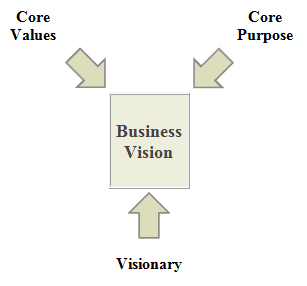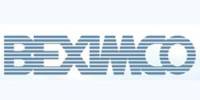Overview
While a business must continually adapt to its competitive environment, there are certain core ideals that remain relatively steady and provide guidance in the process of strategic decision-making. These unchanging ideals form the business vision and are expressed in the company mission statement.
In their 1996 article entitled Building Your Company’s Vision, James Collins and Jerry Porras provided a framework for understanding business vision and articulating it in a mission statement.
The mission statement communicates the firm’s core ideology and visionary goals, generally consisting of the following three components:
- Core values to which the firm is committed
- Core purpose of the firm
- Visionary goals the firm will pursue to fulfill its mission
The firm’s core values and purpose constitute its core ideology and remain relatively constant. They are independent of industry structure and the product life cycle.
The core ideology is not created in a mission statement; rather, the mission statement is simply an expression of what already exists. The specific phrasing of the ideology may change with the times, but the underlying ideology remains constant.
The three components of the business vision can be portrayed as follows:
Core Values
The core values are a few values (no more than five or so) that are central to the firm. Core values reflect the deeply held values of the organization and are independent of the current industry environment and management fads.
One way to determine whether a value is a core value to ask whether it would continue to be supported if circumstances changed and caused it to be seen as a liability. If the answer is that it would be kept, then it is core value. Another way to determine which values are core is to imagine the firm moving into a totally different industry. The values that would be carried with it into the new industry are the core values of the firm.
Core values will not change even if the industry in which the company operates changes. If the industry changes such that the core values are not appreciated, then the firm should seek new markets where its core values are viewed as an asset.
For example, if innovation is a core value but then 10 years down the road innovation is no longer valued by the current customers, rather than change its values the firm should seek new markets where innovation is advantageous.
The following are a few examples of values that some firms has chosen to be in their core:
- excellent customer service
- pioneering technology
- creativity
- integrity
- social responsibility
Core Purpose
The core purpose is the reason that the firm exists. This core purpose is expressed in a carefully formulated mission statement. Like the core values, the core purpose is relatively unchanging and for many firms endures for decades or even centuries. This purpose sets the firm apart from other firms in its industry and sets the direction in which the firm will proceed.
The core purpose is an idealistic reason for being. While firms exist to earn a profit, the profit motive should not be highlighted in the mission statement since it provides little direction to the firm’s employees. What is more important is how the firm will earn its profit since the “how” is what defines the firm.
Initial attempts at stating a core purpose often result in too specific of a statement that focuses on a product or service. To isolate the core purpose, it is useful to ask “why” in response to first-pass, product-oriented mission statements. For example, if a market research firm initially states that its purpose is to provide market research data to its customers, asking “why” leads to the fact that the data is to help customers better understand their markets. Continuing to ask “why” may lead to the revelation that the firm’s core purpose is to assist its clients in reaching their objectives by helping them to better understand their markets.
The core purpose and values of the firm are not selected – they are discovered. The stated ideology should not be a goal or aspiration but rather, it should portray the firm as it really is. Any attempt to state a value that is not already held by the firm’s employees is likely to not be taken seriously.
Visionary Goals
The visionary goals are the lofty objectives that the firm’s management decides to pursue. This vision describes some milestone that the firm will reach in the future and may require a decade or more to achieve. In contrast to the core ideology that the firm discovers, visionary goals are selected.
These visionary goals are longer term and more challenging than strategic or tactical goals. There may be only a 50% chance of realizing the vision, but the firm must believe that it can do so. Collins and Porras describe these lofty objectives as “Big, Hairy, Audacious Goals.” These goals should be challenging enough so that people nearly gasp when they learn of them and realize the effort that will be required to reach them.
Most visionary goals fall into one of the following categories:
- Target – quantitative or qualitative goals such as a sales target or Ford’s goal to “democratize the automobile.”
- Common enemy – centered on overtaking a specific firm such as the 1950’s goal of Philip-Morris to displace RJR.
- Role model – to become like another firm in a different industry or market. For example, a cycling accessories firm might strive to become “the Nike of the cycling industry.”
- Internal transformation – especially appropriate for very large corporations. For example, GE set the goal of becoming number one or number two in every market it serves.
While visionary goals may require significant stretching to achieve, many visionary companies have succeeded in reaching them. Once such a goal is reached, it needs to be replaced; otherwise, it is unlikely that the organization will continue to be successful. For example, Ford succeeded in placing the automobile within the reach of everyday people, but did not replace this goal with a better one and General Motors overtook Ford in the 1930’s.
Recommended Reading
Jeffrey Abrahams, The Mission Statement Book: 301 Corporate Mission Statements from America’s Top Companies
Features 300 mission statements from companies such as:
- American Express
- AT&T Corp.
- Ben & Jerry’s Homemade, Inc.
- Blockbuster Inc.
- Coca-Cola
- Exxon
- FedEx Corporation
- Ford Motor Company
- General Electric Company
- IBM
- Johnson & Johnson
- Kellogg Company
- Levi Strauss & Co.
- Microsoft Corporation
- Nike
- Southwest Airlines Co.
- Tootsie Roll Industries, Inc.
- United Parcel Service
- Washington Mutual Inc.

















